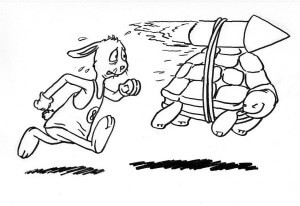Start Slow to go Fast
 Don’t you just love riding a bike? While I appreciate it’s not for everyone, I truly believe there is something freeing about riding a bike. Perhaps it brings back memories of being a child, flying through the neighbourhood on my trusty Malvern Star, exhilarated with the speed and excited about the freedom my bike gave me from the tedious task of walking to school. The fresh air, things whizzing past, cycling from one thing to another. It was freedom.
Don’t you just love riding a bike? While I appreciate it’s not for everyone, I truly believe there is something freeing about riding a bike. Perhaps it brings back memories of being a child, flying through the neighbourhood on my trusty Malvern Star, exhilarated with the speed and excited about the freedom my bike gave me from the tedious task of walking to school. The fresh air, things whizzing past, cycling from one thing to another. It was freedom.
I still cycle, albeit not many things go whizzing past that fast, and sometimes I’m focusing on getting from A to B I don’t appreciate the freedom or the fresh air. Sometimes it’s just to get some exercise in on the weekend. In Melbourne we are blessed with great bike trails and very few hills. Speaking of hills, they do feature in my story – you have been warned.
Starting slow feels weird at first
Because there are so very few hills, I find myself fixed on any slight slope on my ride, building it up beforehand and approaching it with that feeling of “oh no, here comes THAT hill!” One particular hill is pretty steep by normal standards and every time I ride up it, I arrive at the top completely out of breath. The other day I was approaching it with my usual sense of dread, when I came across a number of cyclists just starting out at the bottom. They were spread across the path (that’s not that wide anyway) and were going fairly slowly. I wasn’t going THAT much faster than them that I could have overtaken anyway, but needless to say, I was forced to go down a gear and slow down. It was a beautiful day and I was enjoying being out so much that I didn’t get frustrated, but happily sat into my new pace and followed them up the hill.
It took me a while to realise after I got to the top that I wasn’t puffed out. Could I be getting massively fitter? Um, no. As I pedalled happily on, I realised that because I had taken it slower going up the hill (a good 5km/hr slower), I had arrived at the top in slightly more time but I was feeling fresh and ready to continue my ride.
The experience got me thinking about projects (mind you, lots of experiences do but what can you do?). Often we start a project and rush into it, and in our effort to go fast we can burn ourselves out. We either miss things that take extra energy to fix later, or set unrealistic timeframes that we then have to work frantically to meet. We push ourselves hard from the bottom of the first hill, and do not tend to gain much from it apart from being slightly ahead (that we risk losing later) and puffed out.
Agile projects start slow – and then pick up pace
Agile Project Management encourage teams to ‘start slow to go fast’. It can be easy to get carried away and jump into things, but if we take the time to do our thinking and planning, things tend to flow a lot better. A common misconception of Agile is that there is no planning done. This could not be further from the truth. Projects embracing Agile concepts not only plan well at the start, but take time to reflect throughout, and re-plan if necessary. The planning is collaborative and a great opportunity to engage stakeholders from the start. The collaborative element can be challenging for some (not everyone loves a workshop – who knew?) but worth it for the high level of engagement and energy, not to mention great feedback so adjustments can be made. It feels slow because people want to get started, but it’s totally worth it.
In the same way as you check you have your keys, lunch and other items you need for your day before racing out the door (you do, don’t you??) you should take the time at the start of any project or change. It will pay off later in more ways than you can imagine.
Unfortunately, I seem to be able to find more case studies that prove this is true through doing it wrong. How about you? What stories do you have to share where starting slow worked? Or starting fast didn’t?

